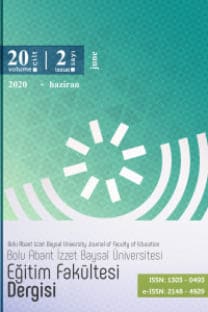Devlet Üniversitelerindeki Fakülteler için Teknoloji Planlamasından Çıkarılan Sonuçlar
Planlama, Teknoloji Planlaması, Teknolojik Alt Yapı, Teknoloji entegrasyonu
Conclusions from Technology Planning for Faculties in State Universities
Planning Technology Planning, University, Technological Infrastructure, Technology Integration,
___
- Anderson, L. S. (1996). Guidebook for Developing an Effective Instructional Technology Plan, Version 2.0. National Center for Technology Planning: Mississippi State.
- Bergmann, B. (1991). Bloated administration, blighted campuses. Academe, 68, 12-16.
- Cradler, J. (1996). Implementing technology in education: Recent findings from research and evaluation studies [Online]. Available: http://www.wested.org/techpolicy/refind.html (İnternetten 8 Nisan 2017 tarihinde elde edilmiştir).
- Eisenberg, M. (2013). 3D printing for children: What to build next? International Journal of Child‐Computer Interaction, 1(1), 7‐13.
- Hopey, Christopher E. & Harvey-Morgan, Joyce. & National Center on Adult Literacy, Philadelphia, PA. (1995). Technology Planning for Adult Literacy. Practice Guide. [Washington, D.C.]: Distributed by ERIC Clearinghouse, https://eric.ed.gov/?id=ED393007
- Kılıçer, K. (2008) Teknolojik yeniliklerin yayılmasını ve benimsenmesini arttıran etmenler, Anadolu Üniversitesi Sosyal Bilimler Dergisi, 8 (2), 209-222.
- Kostakis, V., Niaros, V., & Giotitsas, C. (2015). Open source 3D printing as a means of learning: An educational experiment in two high schools in Greece. Telematics and Informatics, 32(1), 118‐128
- Many, W. F., 81 Zernsb, R. (1 996). Information technology and academic productivity. Education Review, 3(1), 12-14.
- Margaret L. Rice & Michael T. Miller (2001) Faculty Involvement in Planning for the Use and Integration of Instructional and Administrative Technologies, Journal of Research on Computing in Education, 33:3, 328-336, DOI: 10.1080/08886504.2001.10782318
- Massy, W. F. & Zemsky, R. (1995). Information technology and academic productivity. Educom Review, 31(1), 12-14.
- Miles, A. S. (1997). College law (2" ed.). Tuscaloosa, AL: Sevgo
- Miller, M. T., Garavalia, B. J., & McCormack, T. F. (1997). Community college faculty involvement in governance: Implications for teaching. Michigan Community College Journal, 3(1), 51-61.
- NCES (2002). Technology in Schools: Suggestions, Tools, and Guidelines for Assessing Technology in Elementary and Secondary Education. Washington DC: U.S. Department of Education.
- Öksüz, C. Ak, Ş. ve Uça, S. (2009). İlköğretim Matematik Öğretiminde Teknoloji Kullanımına İlişkin Algı Ölçeği, Yüzüncü Yıl Üniversitesi Eğitim Fakültesi Dergisi, 6 (1), 270-287. Web: http://efdergi.yyu.edu.tr/
- Ringle, M., 81 Updegove, D. (1998). Is strategic planning for technology an oxymoron? Cause / Effect, 21 (1), 18-23.
- Rogers, E., (1995). Diffusion of Innovations (third edition). NY: The Free Press
- Rogers, M. E. (2003). Diffusion of innovations (Fifth edition). New York: Free Press.
- Saban, A (2006). Okul Teknoloji Planlaması: İlköğretim Okulları İçin Uygulamalı Bir Model Önerisi ve Öğretmen Yetiştirme Sistemi Açısından Sonuçları. Yayınlanmamış Doktora Tezi, S.Ü. SosyalBilimler Enstitüsü.
- Saban, A. (2007). Seçmeci okul teknoloji planlama modeli ve Özel Konya Esentepe İlköğretim Okulu teknoloji profili. Erciyes Üniversitesi Sosyal Bilimler Enstitüsü Dergisi, 1(22), 23-43.
- Seferoğlu, S. S. (2009). İlköğretim okullarında teknoloji kullanımı ve yöneticilerin bakış açıları. XI. Akademik Bilişim Konferansı (AB09) Bildirileri. 403-410. Harran Üniversitesi, Şanlıurfa.
- Sibley, P.H.R. & Kimball, C. (2004). Technology planning: the good, the bad and the ugly[Online]. Available http://www2.edmin.com/news/library/index.cfm?function= showLibraryDetail&library_id=16 (İnternetten 08 Nisan 2017 tarihinde elde edilmiştir).
- Thomas, R.M. (1998). Conducting educational research: A comparative view. West Port, Conn: Bergin & Garvey.
- Vanderlinde, R., van Braak, J., De Windt, V., Tondeur, J., Hermans, R. I., & Sinnaeve, I. (2008). Technology curriculum and planning for technology in schools: The Flemish case. TechTrends, 52(2), 23-26.
- Yıldırım, A. & Şimşek, H. (2006). Sosyal Bilimlerde Nitel Araştırma Yöntemleri. Ankara: Seçkin.
- Yukselturk, E. & Curaoglu, O. (2013). Blended Assessment Methods in Online Educational Programs in Turkey: Issues and Strategies. In M. Khosrow-Pour, D.B.A. (Ed.), Cases on Assessment and Evaluation in Education (pp. 340-362). IGI Global. https://doi.org/10.4018/978-1-4666-2621-8.ch014
- ISSN: 1303-0493
- Yayın Aralığı: Yılda 4 Sayı
- Başlangıç: 2000
- Yayıncı: Abant İzzet Baysal Üniversitesi Eğitim Fakültesi
Pygmalion Ölçeği'nin (PÖ) Geliştirilmesi: Geçerlik ve Güvenirlik Çalışması
Öğretmenlerin Gözüyle Çevre Sorunları ve Çevre Sorunlarına İlişkin Çözüm Önerileri
Fatıma Betül DEMİR, Ülkü ULUKAYA ÖTELEŞ
Temel Bir Beceri Olarak Finansal Okuryazarlığın Sosyal Bilgiler Dersine Yansıması
Öğretmen İş Gücü Devir Hızının (Öğretmen Sirkülasyonunun) Avantaj ve Dezavantajları: Siirt Örneği
Zarnigora USHUROVA, Rasim TÖSTEN, Fettah KAYRA
Öğretmenlerin Eğitim Politikaları Bağlamında Moral Yitimleri ve Okul Etkililiği Arasındaki İlişki
Ümit DİLEKÇİ, İbrahim LİMON, Ayça KAYA
Kovid 19 Pandemi Süreciyle İlgili Okul Yöneticileri ve Öğretmenlerin Görüşleri
İzzet KAPLAN, Celal Teyyar UĞURLU
Reyhan GEÇDOĞAN YILMAZ, Bahri AYDIN
Müzik Öğretmenlerinin Çalışmaya Tutkunluk Durumlarının Bazı Demografik Değişkenlere Göre İncelenmesi
Cansın Nehir MANSUROĞLU, Ersin TURHAL
İngilizce Öğretmenlerinin Tek Cinsiyetli Sınıflarda İngilizce Öğretimi ile İlgili Algıları
